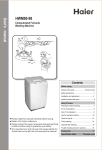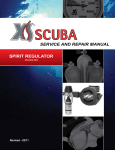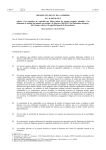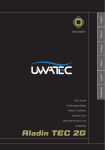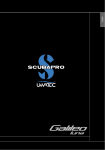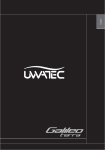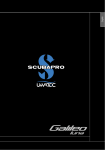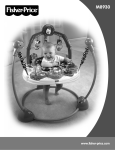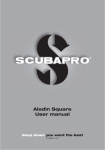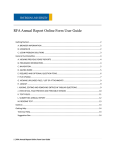Download Regulator “I Gottachas”
Transcript
KEEPING THE REAPER AWAY FROM YOUR REGULATORS Break-Out Session November 17, 2007 Presented by: Jack Gregory NACD Life Member and Master Equipment Technician, The Dive Shop, Inc. Marietta, GA (Revised 06/16/2012) Regulator “I Gotchas” The smartest thing to do with your regulators is to have them serviced/repaired by a motivated, competent and qualified factory authorized technician...one who has a proven track record working on 1st and 2nd Stages in the technical diving community. These people are not impossible to find. Not only is it safer for you, liability is transferred to the entity doing the work if something were to go wrong at depth. Having said that, I am well aware that most in this group work on their own equipment (and always will), having access to specialized tools, parts, and repair guides thru all sorts of current and past associations. Some of you are even part-time Factory Authorized Technicians for different manufactures. Recognizing that all y’all have been, and will continue to be, doing your own servicing and rebuilds, our intent here today is to simply try to cover some of the things that YOU need to be mindful of when working on your own personal equipment. Unless you are one of those “part-timers” who runs all of their work through the LDS who employs them, I’d strongly suggest that you refrain from volunteering to work on other people’s equipment. If something bad were to happen due to a servicing mistake made by you, that “friend” (or their heirs) may turn out to be your free ticket to a nightmare of litigation for the next 5 years! So, if you are going to work on your own equipment, BEWARE of the following Grim Reaper “I Gotchas” Servicing regulators without having a copy of the schematic and/or the Service Manual/TIB(s). Don’t copy what you found in the regulator! Oftentimes, parts show up in regs that should not be there or they are missing other critical pieces…and the repeat is then made during servicing by “copying” what was in the regulator. Extra O rings, up-side down bushings and guides, backwards installations, and all sorts of other things that either should not be there and are, or other important components that should be there and aren’t! DO NOT work on a reg set unless you have the schematic, no matter how many times that you have worked on the same one and “think” that you know it…always have the appropriate documentation in front of you when doing the work. If you can, work from specific Service Manuals that are published for most modern-day high performance regulators. Most of you know where to find the necessary schematic(s) and other important information. Additionally, there are, in my opinion, two publications that anyone working on regulators should own: (1) SCUBA Regulator Maintenance and Repair by Vance Harlow: (http://www.airspeedpress.com). The book has a bunch of good common-sense suggestions and go-bys. It does need updating in a few places. The other book (2) is SCUBA Regulator Savvy, by Pete Wolfinger: (http://www.scubatools.com/c-23-regulator-savvy-book.aspx). This book does a good job in covering theory. Most of the examples used come from the Scubapro line…along with the very well done illustrations. GET BOTH BOOKS. Actually, one good way to learn about hands-on regulator assembly/adjustments comes from the instruction sheets that are provided with each individual tool sold by ScubaTools. Not performing an adequate Pre-Check on the systems to be taken down. As a minimum, note 1st Stage IP, 2nd Stage Cracking, Leak/Bubble Checks for both Stages, overall hose condition, and other relevant tests pertinent to the model of the regulator BEFORE you start to take it apart. Continuing to dive regulators (and other equipment) subject to recall notices without fixing the problem that caused the recall. “Well, I didn’t know mine was on the list?” Here is the list: http://www.cdnn.info/recall/recall.html. The folks at CDNN do an excellent job of keeping this list current all the way back to the first official SCUBA recall circa June, 1977. It also matches up nicely with what’s on the CPSC site: http://www.cpsc.gov/cpscpub/prerel/prerel.html, but without having to do time-consuming sorts. Also be aware that manufactures have the option of issuing a “Safety Notice” outside of a full-blown CPSC Recall (or Voluntary Recall). If that happens you may never know about these unless you are diligent in staying up on things with that particular manufacturer. Most Safety Notices will be posted on the manufacture’s consumer portion of their web-site. Modifying regulators without thinking thru the unintended consequences. For example, keeping second stage covers loose so they can be “cleaned-out” during in-water use, when on some models, a loose second stage cover allows water to enter under the diaphragm, causing a major Goat Rope in places where you want NO Goat Rope going on. Or, adding aftermarket “goodies” to 1st and 2nd Stages, or their hoses, without knowing about their failure points or failure history can compound failure. Or, turning an older piston 1st Stage into a deco reg when the service manual specifically prohibits using it with gas that’s greater than EAN 40. Putting in parts that you think will substitute for the original without knowing for sure they are an exact duplicate or proper fit. For example, not mikeing, measuring, and/or doing an adequate job of comparing the counterfeit part with the original part that’s being replaced may lead to failure. Putting in O-Rings that “look like they came from the Kit” without being absolutely sure that they match for size and shore hardness can reduce performance. Doing what Vance Harlow (above) refers to as an “Underhaul.” Where all you do is to “throw in a Parts Kit”, and fail to properly clean all parts of the stage or notice that other parts are worn, damaged or missing. This is probably a good place to mention that if you work on your own regs, you need to know about how they actually work rather than just be a parts replacer or a procedures follower. By understanding about how the opposing forces, flow paths, and different pressures affect your reg sets, you are in a better position to diagnose problems that continue after you have put in a new kit 3-4 times. Pete Wolfinger makes a point of this by emphasizing that folks working on regulators need to be able to think rationally and understand the “whys” rather than just following a set of procedures. Not obtaining the right tools/and or chemicals to do the job. Folks, this is the 21 Century. You really don’t need to be using Vinegar for cleaning, silicone grease for lubricants, a crescent wrench and screwdriver as your only tools, and the toilet bowl for setting the cracking pressure. Buy the right tools and test instruments for the intended job and ASK other experienced technicians (rather than take as gospel everything you see on various Internet Forums) what they are using for tools and chemicals and how they are using them. Working on Primary Regulator set(s) but not Stage or Deco Regulators Failures in Stage and Deco Regulators happen more than you may think. After working on a primary set there is a tendency not to overhaul stage and/or deco regs due to a perception they are “used less.” You don’t want to be in the middle of an extended range dive and have these babies fail! Not checking/overhauling BC OPV’s, their pull cords, and inflator inlets. Not checking cylinder valves, HP Spools, any swivels, hose shrader valves and O-Rings. Make sure to do all of these at the same time that you work on your main regulators. These items can involve life support emergencies if overlooked! There are common themes running throughout the above: Know what you are doing….as there may be serious consequences for both you and your dive buddies if you don’t. Have the necessary resources available BEFORE you start work. Don’t take shortcuts. Attached is a copy of the Protocol that I use at the Shop each time I work on a system. It may help you as a check list while you are working on yours. If you have questions about anything discussed or about a specific issue with your system…please don’t hesitate to contact me on my cell # below. SAFE DIVING! /s/ Jack "Jumpin" Jack Gregory Lead Master SCUBA Equipment Repair Technician NACD & TDI Cave-DPV/Advanced Trimix Diver The Dive Shop, Inc. 2714 Sandy Plains Road Marietta, GA 30066 Cell Phone: 770-789-0471 Shop Phone: 770-973-7909 THE DIVE SHOP, MARIETTA, EQUIPMENT SERVICE LOG (___) of (___) (ONE SERVICE LOG PER AIR DELIVERY SYSTEM) NAME: _______________________________CONTACT # ______________________ RWO/INVOICE NUMBER: ____________/___________ LAST SERVICE DATE: ____/____ SERVICE KITS COVERED? (Y/N) EXPLANATION__________________________________________ _____________________________________ SERVICE TO BE PERFORMED 1st STAGE: (Y/N). 2nd STAGE: (Y/N). OCTO/AIR: (Y/N). ______________________ COMPUTER BATTERY CHANGE: (Y/N). COMPUTER DEPTH ACCURACY TEST: (Y/N). COMPUTER HP HOSE QDC/HP HOSE SPOOL & SPG ACCURACY TEST: (Y/N). ANALOG DEPTH GAUGE ACCURACY TEST: (Y/N). ANALOG SPG HP HOSE SPOOL & ACCURACY TEST: (Y/N). BCD INTEGRITY AND INFLATOR REBUILD: (Y/N). OTHER SERVICE:_______________________________________________________________ HOSE CONFIGURATION SERIAL NUMBERS & SERVICE KITS / PARTS USED MFGR 1ST STAGE PRIMARY OCTO/AIR COMPUTER SP GAUGE DEPTH BCD/INFLTR OTHER MODEL S/N SERVICE KITS USED & APPLICABLE COSTS ___________________|__________________|____________________|_____________________________________ ___________________|__________________|____________________|_____________________________________ ___________________|__________________|____________________|_____________________________________ ___________________|__________________|____________________|_____________________________________ ___________________|__________________|____________________|_____________________________________ ___________________|__________________|____________________|_____________________________________ ___________________|__________________|____________________|_____________________________________ ___________________|__________________|____________________|_____________________________________ SERVICE CHECKLIST/CONFIRMATION (All Items 1-14) (1): SERVICE NOTICES AND RECALLS CHECKED : ______________________________________________________________________. (2): FIRST STAGE MAIN SPRING SHIMS: PRE-REPAIR (_______). POST-REPAIR (_____). (3): ALL REQUIRED TORQUE SPECIFICATIONS MET (_). (4): 1ST STAGE IP LOCKUP CONFIRMED FOR _____ MIN (_). (5): 2ND STAGES: PRI LEAK TEST CHECK (_) _____ @ 3"H2O (N/A). OCTO LEAK TEST CHECK (_) ______ @ 3"H2O (N/A). (6): 1ST & 2ND STAGES BREAK-IN FOR 5 MINUTES) (_). (7): SPG MATCHES BENCH GAUGES @ 500/3000 PSI (Y/N) (N/A). (8): INFLATOR HOSE O-RINGS, SHRADER VALVE, AND/OR AIR QUICK DISCONNECT O-RINGS REPLACED (_) (N/A). (9): 2ND STAGE HOSES O-RINGS REPLACED (_) (N/A). (10): HI-PRESSURE HOSE AIR SPOOL O-RINGS REPLACED (_) (N/A). (11): 1st & 2ND STAGES CLEANED FOR NITROX NTE 40% (_). (12): ADDITIONAL 100% O2 CIP SERVICE RATING (_) (N/A). (13): BCD BLADDER DISINFCT & INTEGRITY CHECKED (_) (N/A). (14): IN-WATER BUBBLE LEAK TEST ALL PIECES (_) FIRST STAGE INTERMEDIATE STATIC PRESSURE TESTS PRE-REPAIR READINGS Is the IP Supply Static IP (C)reeping (PSI) (PSI) or (H)olding? 500 3000 ANY PRE-REPAIR 1st STAGE ISSUES? POST-REPAIR READINGS Is the IP Supply Static IP (C)reeping (PSI) (PSI) or (H)olding? 500 3000 IP is OK and SET FOR THE FOLLOWING PRIMARY 2nd STAGE: SECOND STAGE(S) STATIC MAGNEHELIC VALUES Static Opening Knob Out Knob In Effort "H2O "H2O Primary Pre-Repair Octo Pre-Repair Primary Post-Repair Octo Post-Repair DEPTH ACCURACY TEST CHAMBER DEPTH Reads +/- CHAMBER DEPTH 10 fsw 120 fsw 20 fsw 140 fsw 40 fsw 160 fsw 60 fsw 180 fsw 80 fsw 200 fsw 100 fsw Ending Reads +/- DEPTH ACCURACY (PASS/FAIL) ASCENT WARNING (PASS/FAIL/ N/A) PRIMARY SECOND STAGE DYNAMIC FLOW ANALYZER with VALUES @ 3000 psi Venturi Venturi Closed Open Min Opening MIN & Effort MAX @ IP Drop "H2O "H2O FLOW Dynamic Flow VALUES Effort OK? @ 5 SCFM "H2O "H2O Dynamic Flow Y/N/ NA Effort NOTES: @ 7.5 SCFM "H2O "H2O Dynamic Flow Effort @ 10 SCFM "H2O "H2O Dynamic Flow Effort @ 12 SCFM "H2O "H2O Rates OK? Cross-Over ______ ______ Y/N/ NA Flow Rate SCFM SCFM IP OK? 1ST Stage Dynamic IP @ ______ ______ Y/N/ NA 10 SCFM PSI PSI NOTES:_____________________________________________________________________________________________________________________ ____________________________________________________________________________________________________________________________ ____________________________________________________________________________________________________________________________ TECHNICIAN SIGNATURE:_________________________________________ DATE:_____/_____/_____ PLEASE “TEST DIVE” YOUR SYSTEM IN THE SHOP’S POOL (at no cost) PRIOR TO USING IT ON A TRIP!







